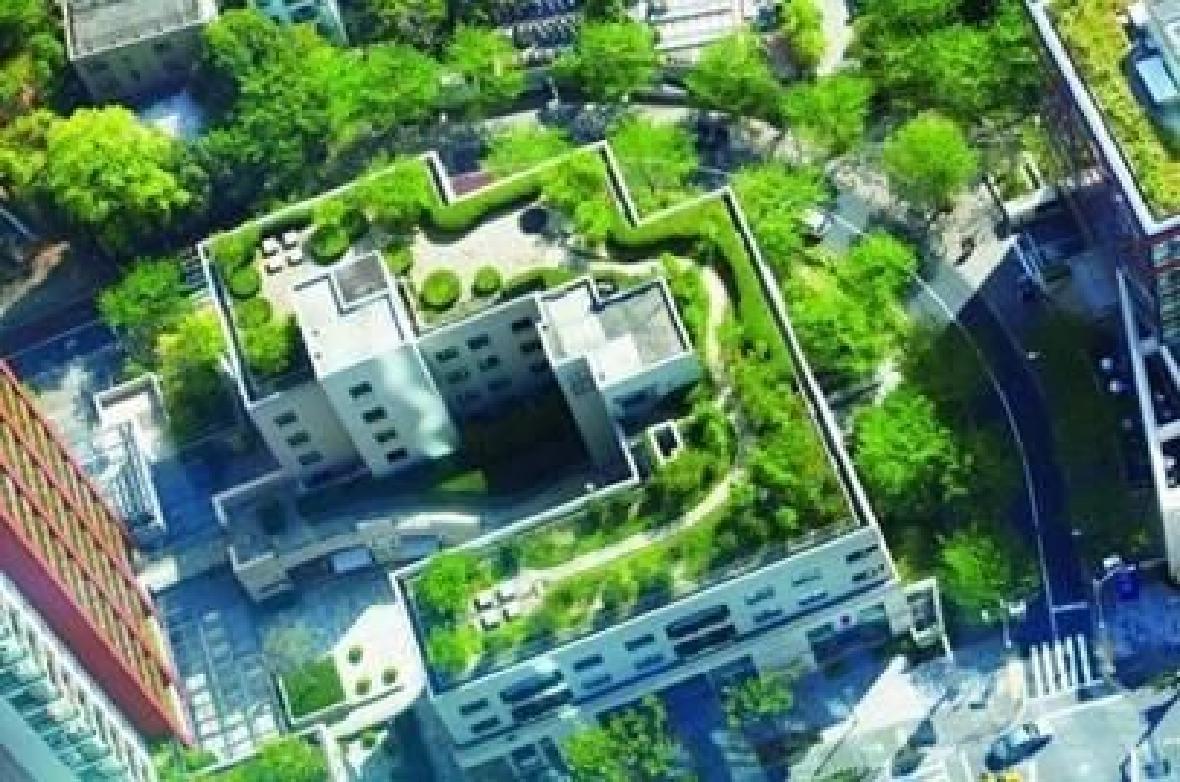08
2019
-
01
Sponge City Construction and Geosynthetics (3): Geosynthetics in Green Roof Engineering
Author:
I. Concept and Advantages of Green Roof
Green roof is also known as planting roof, roof greening and so on. According to the depth of planting matrix and the complexity of landscape, green roof can be divided into simple type and garden type.
Building a green roof can add a fresh green color to the urban construction forest of reinforced concrete. At the same time, it can also beautify the environment, purify the air, reduce the temperature in buildings, save energy and reduce emissions. It is an important measure to realize the construction of sponge city. Although green roof is still in the stage of promotion due to economic cost and other factors in urban construction, it is not common, but its prospects are very broad.
2. Structural Floor of General Green Roof
Conventional green roof structure layer combination is: vegetation layer + 100-150 thick improved soil + geotextile filter layer + 15-20 mm thick concave-convex drainage (storage) water plate + flexible protective layer + waterproof layer + ordinary waterproof layer + 20 mm thick emulsified asphalt expanded perlite local slope adjustment + 30-60 mm thick polystyrene foam plastic plate + 20 mm thick 1:3 cement mortar leveling layer + reinforced concrete roof panel.

Function and Performance Requirements of Geosynthetics in Green Roof
(1) Root puncture resistant waterproof layer
Root puncture resistant waterproof layer should have water resistance, corrosion resistance, mildew resistance, plant root puncture resistance, and strong adaptability to base expansion/cracking deformation. The penetration of roots in the process of plant growth can not be blocked by common waterproof materials, especially some materials which contain affinity enzymes of plant roots. Such materials not only can not prevent root thorns, but also can attract plant roots to grow and take root downward, eventually leading to serious damage to the material itself and even the main structure.
Root-blocking and puncture-resistant waterproofing materials should have the qualified certificate of the root-blocking experiments of authoritative institutions abroad, but at present, they are inspected by practical experience in China. At present, the effective root-resistance and waterproofing geosynthetics proved by theoretical certification and practice mainly include copper matrix composite waterproofing material, polyvinyl chloride waterproofing membrane (PVC), thermoplastic polyolefin waterproofing membrane (TPO), alloy waterproofing membrane (PSS), high density polyethylene geomembrane waterproofing membrane (HDPE), polyethylene matrix polymer modified asphalt waterproofing membrane (PPE), polyethylene polypropylene waterproofing membrane matching. The self-adhesive waterproofing material of coated adhesives and EVA macromolecule composite. Taking the copper matrix waterproofing material as an example, this kind of material adds biological root-blocking additives to SBS modified asphalt, or takes copper-polyester composite matrix as interlayer in the middle, and uses copper element to inhibit and block the growth of plant root system, so as to realize the root-blocking performance of waterproofing material.
(2) Drainage Layer
The function of drainage layer is to discharge excessive water to prevent plant rotting roots, so as to lighten the burden of waterproof layer. As a drainage layer, geosynthetics should have a certain thickness, large porosity, good permeability, and good resistance to bursting and tearing. High density polyethylene (HDPE) drainage board is used widely in the existing roof greening drainage layer. When this kind of product is applied to roof engineering, it can be directly laid on the waterproof layer and welded (fastened) to replace the rigid protective layer of reinforced concrete 7 cm thick above the traditional waterproof layer in the roof, thus making the protective layer from rigid to flexible, making the construction more simple and fast, and from the traditional waterproof layer to the rigid protective layer. The damage to the completed waterproof layer during the construction of the rigid protective layer is substantially reduced. HDPE drainage protection board itself is composed of high density polyethylene, high density polyethylene itself is resistant to plant root puncture, and high density polyethylene products have stable performance, good chemical corrosion resistance and durability.
(3) Isolation filter layer
The function of isolation filter layer is not to let the soil of plant layer seep into drainage layer, prevent soil and water loss, and make the excess water of soil drain into drainage layer. The selection of filter materials should be materials that can drain water and isolate fine soil particles in plant planting layer, and which are corrosion-resistant and puncture-resistant to plant roots. The condition of retaining soil, water permeability and silting effect should be taken into account to realize and maintain the filtering function.
Teandersheng Building Materials Co., Ltd. welcomes your call to consult geosynthetics geogrid, geotextile, geomembrane, tunnel waterproof board, EVA waterproof board and other geotechnical materials.
undefined




